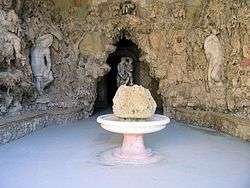Bernardo Buontalenti

Bernardo Buontalenti (Italian pronunciation: [berˈnardo ˌbwɔntaˈlɛnti]), byname of Bernardo Delle Girandole (c. 1531 – 25 or 26 June 1608), was an Italian stage designer, architect, theatrical designer, military engineer and artist.
Biography
Buontalenti was born in Florence.
He entered the service of the Medici as a youth and remained with them the rest of his life. He is said to have been instructed in painting by Salviati and Bronzino, in sculpture by Michelangelo Buonarroti, in architecture by Giorgio Vasari, and to have learned miniature painting under Giulio Clovio. He executed a number of miniatures for Francesco, the son of Cosimo I. More than a painter, he was celebrated as an architect; in this role he was much employed in the design of fortifications, villas, and gardens and is considered one of the most important architects of the Mannerist period. He was also a great mechanic, and an excellent mathematician. In 1562 he travelled to Spain.
His first known work is from 1568, the Palazzo di Bianca Cappello in Florence. His main achievements include the project for the new city of Livorno, the decoration of Palazzo Pitti and the Boboli Gardens with the famous grotto, as well as the Parco di Pratolino of which little remains today, except for a giant sculpture by Giambologna, representing the Colossus of the Apennines. Buontalenti's skills as a military engineer are shown by the fortifications of the port of Livorno, the Forte di Belvedere in Florence, the city walls of Pistoia, Grosseto, Prato, Portoferraio (Elba) and Naples; he also perfected designs for cannons, and devised a new type of incendiary grenade.
In the Uffizi Palace of Florence, he built a great court stage, where, during the winter of 1585–1586, splendid festivities were produced under his direction. He designed costumes for the Medici extravaganzas.
Despite his successes, his prodigality led Buontalenti to financial ruin; he survived in his later life thanks to a pension given him by the Grand Duke of Tuscany.
References
| Wikimedia Commons has media related to Bernardo Buontalenti. |
- Bryan, Michael (1886). Robert Edmund Graves, ed. Dictionary of Painters and Engravers, Biographical and Critical (Volume I: A-K). York St. #4, Covent Garden, London; Original from Fogg Library, Digitized May 18, 2007: George Bell and Sons.
- Bernardo Buontalenti and the Grotta Grande of Boboli, Florence: Maschietto Editore, 2012. ISBN 978-88-6394-041-1